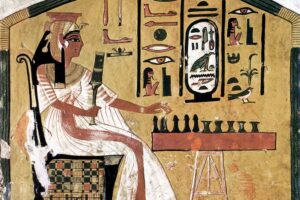Before the invention of the printing press, books were copied by writing down the text.
This was an extensive work and monks were specially trained for it. They were working during daylight hours in the so-called scripotorium – the monastery’s office – where they wrote down the text of the books.
But the monks had to do many other things, such as cutting the book covers, mixing the ink, binding the books together and making covers.
Finally, the books were sent to monks who specialized in decorating initials – and eventually to illustrators.
How long it took the monks to copy one book depended on many factors, including the content and length of the book.
It often happened that the monks had to copy languages they did not fully understand – for example ancient Greek and Hebrew – and the writing had to be uniform.
Two books a year
This was therefore an extremely time-consuming manual work that could take many months.
The rule of thumb was that one monk could copy two books a year.
Special books like the Bible were more difficult and required up to 15 months of work to copy. As a result, such manuscripts were only available to the wealthiest people.
After the advent of the printing press in the 1440s, books became significantly cheaper. While one monk could copy about three to four pages a day, the printing press could print more than 3,000 pages.
Up to 40 monks spent the whole day and night copying books in large monasteries.
The monks were under great pressure to write an error-free text, but research has shown that medieval books are often riddled with errors. For example, monks often left out many lines when writing books in a language they did not understand
The spam filters were often used to complain. The monks who toiled all day, often suffered from backaches and dry eyes, wrote, for example: “I’m so cold” and “Oh, the backaches” in the margin. One monk was overjoyed at the end of the work: “Now I have copied everything – for God’s sake give me a drink”.
The pens were made of, among other things, metal and bird feathers. Metal pens gave a thin and precise line. It was possible to erase the pens according to the needs of each individual.
The book cover was made from animal hides that were tanned and stretched. Sometimes skins from hundreds of animals were needed for one book. To ensure the highest quality, larger monasteries kept their own livestock.








